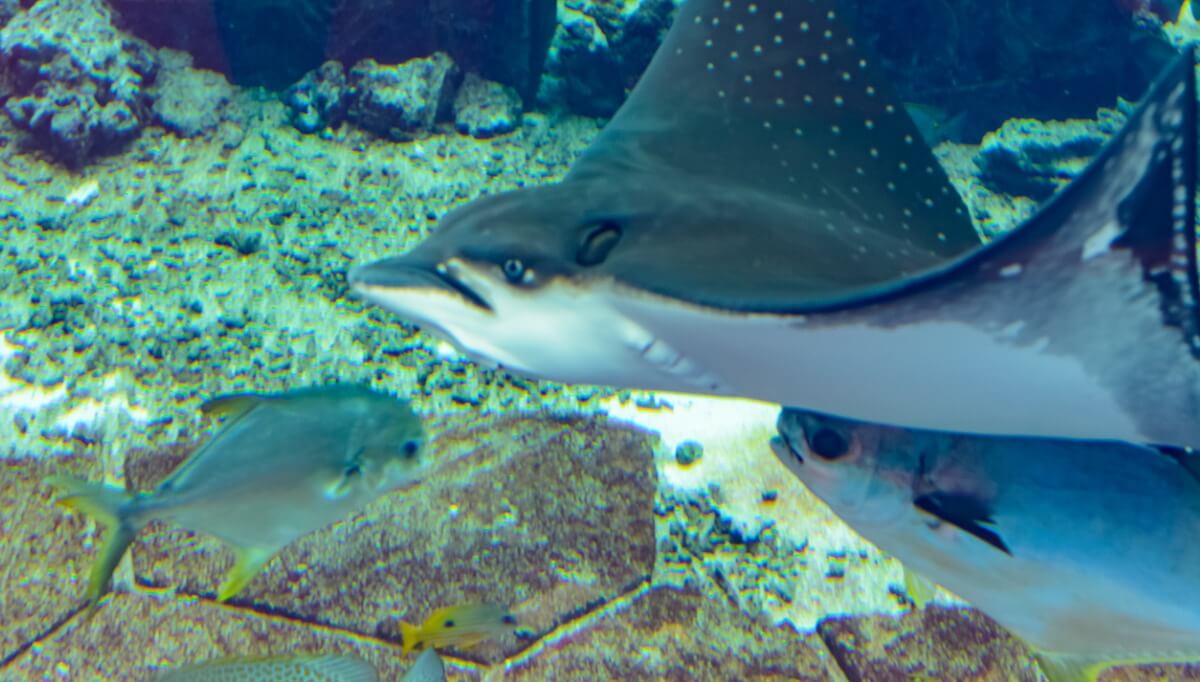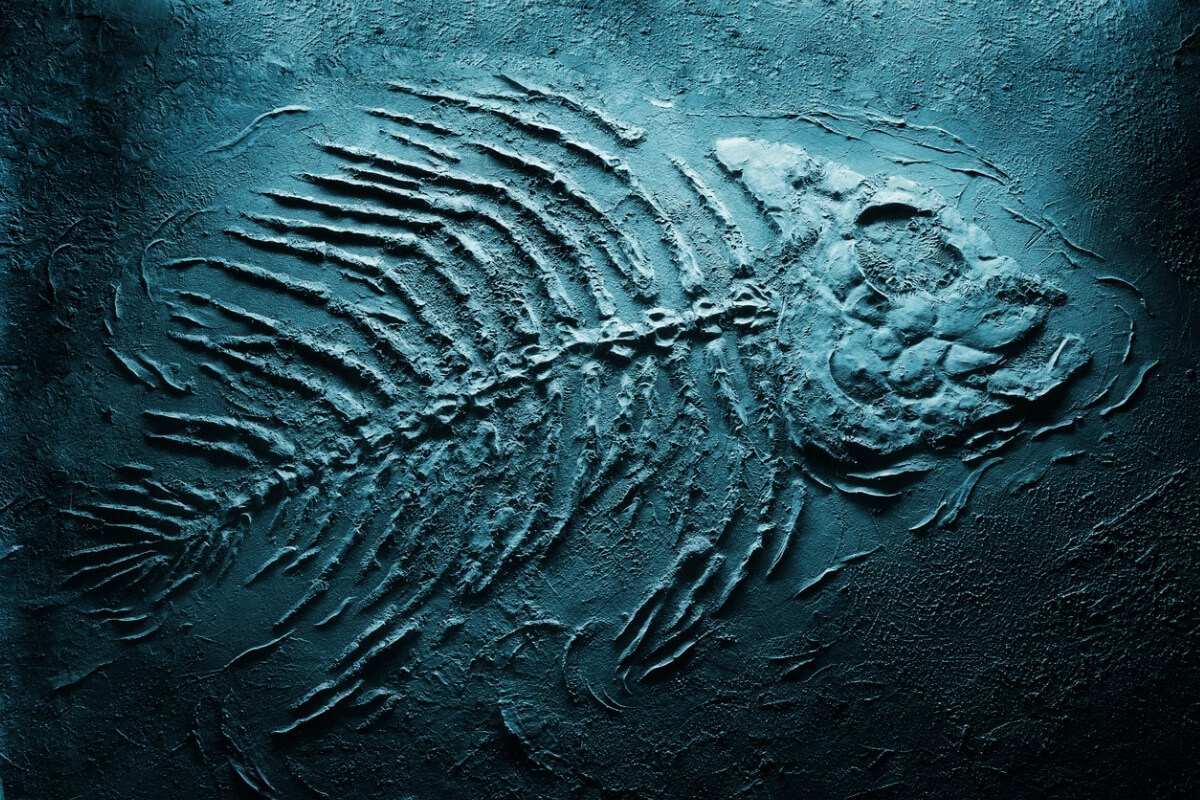Eagle Shark: A 93 Million Year Old Fossil


Written and verified by the biologist Francisco Morata Carramolino
Today, most shark species are very similar to each other, with marked predatory habits and a torpedo shape. A study published this year in the journal Science has described a new species, called the eagle shark or Aquilolamna milarcae, whose existence indicates that this wasn’t always the case.
This strange marine animal lived 93 million years ago on the current Vallecillo, in Mexico. The fossils of this aquatic creature have been excellently preserved – which is very rare for sharks – and show a unique morphology.
The discovery of the eagle shark sheds new light on the past biodiversity of elasmobranchs, inhabitants of the seas before humans arrived on the planet. If you want to know more about them, keep reading.
Eagle shark characteristics
This ancient chondrichthyan stands out for its completely unusual appearance. Despite being a shark, several of its characteristics are reminiscent of today’s manta rays.
Aquilolamna’s body is elongated, hydrodynamic, and tube-shaped, as in other sharks. It also ends in a heteroclose caudal fin, consisting of a longer upper lobe and a smaller lower lobe, both triangular in shape.
Without a doubt, the most striking aspect of the eagle shark is its gigantic pectoral fins, which in modern sharks are quite small. While this animal measured 1.65 meters (5.4 feet) from head to tail, the wingspan of its fins reached 1.9 meters (6.2 feet).
These pectoral fins, thin and extremely long, possibly ended in a point. They’re reminiscent of a kind of aquatic wings, hence the name that the animal has received.
Curiously, Aquilolamna doesn’t seem to have the other typical shark fins. This study, published in the prestigious journal Science, hasn’t found dorsal fins – the characteristic triangle on the back – or pelvic fins, which would be located below and closer to the tail.
The head of this animal is short and blunt, with a wide mouth, far removed from the pointed head that is more common today. No teeth have been found, suggesting they were missing or very small.

Way of life and evolution
As already mentioned, the appearance of this animal reminds us of the current day stingrays. Their ecology and way of life were also tremendously similar.
It’s possible that the eagle shark swam by moving its fins in a kind of underwater flight, as do the mantas. It was also able to swim slowly by propelling itself with its tail. In this case, the pectoral fins would only be large motor stabilizers.
Also, the shape of the head, absence of teeth, and slow swimming indicate that this animal wasn’t a predator. The eagle shark fed by filtration, and opened its mouth to swallow large amounts of plankton, as do whale sharks, basking sharks and, of course, stingrays.
Despite the similarities, the eagle shark wasn’t related to mantas or other batoids. This is an example of evolutionary convergence: both organisms are similar and occupy the same ecological niche, but they got to this point by following independent paths.
Aquilolamna disappeared 66 million years ago, in the Cretaceous-Paleogene extinction. Manta rays and other filter-feeding chondrichthyans began to appear around 30 million years later.
The discovery of the eagle shark
Aquilolamna was found in 2012 in the limestone quarries of Vallecillo, in Mexico. These areas are famous at an archaeological level, as they are home to a large number of impressive fossils.
Interestingly, this fossil retains most of the skeleton, but not the teeth. The usual thing among sharks is just the opposite: only the teeth tend to fossilize, since they’re the only bony parts. The rest of the skeleton is cartilaginous and isn’t usually preserved.
So much so that, to this day, the taxonomy of sharks is largely based on teeth. As this specimen doesn’t have them, it’s very difficult to determine their exact classification. To be totally sure, further studies will be necessary.
On the other hand, this discovery also indicates that other fossil sharks might be weirder than expected. Since only the teeth are known, it’s impossible to guess what they would look like in real life. It should be noted that even the appearance of such famous animals as the megalodon is unknown.
Ethical considerations
While this article has provided significant and novel information, it also raises unpleasant ethical considerations. The study of fossils from low-income countries tends to carry colonialist and exploitative practices, something very frowned upon in today’s society from an ethical and moral point of view.
These countries have implemented laws to combat such practices and prevent the looting of their cultural and paleontological heritage. Still, a very lucrative black market dealing in fossils has emerged in response to these bans.
Some authors indicate that the fossil of the whale shark could have been obtained in a dubious way, by taking advantage of legal loopholes, violating ethical codes and dispensing with collaboration with native scientists. Without a doubt, this highlights the darkest part of paleontology in the West.

Be that as it may, the discovery of this animal has been a revolution for the scientific community in the field of evolution. Its existence shows that we know very little about the way of life and appearance of the fish that once inhabited our seas.
Today, most shark species are very similar to each other, with marked predatory habits and a torpedo shape. A study published this year in the journal Science has described a new species, called the eagle shark or Aquilolamna milarcae, whose existence indicates that this wasn’t always the case.
This strange marine animal lived 93 million years ago on the current Vallecillo, in Mexico. The fossils of this aquatic creature have been excellently preserved – which is very rare for sharks – and show a unique morphology.
The discovery of the eagle shark sheds new light on the past biodiversity of elasmobranchs, inhabitants of the seas before humans arrived on the planet. If you want to know more about them, keep reading.
Eagle shark characteristics
This ancient chondrichthyan stands out for its completely unusual appearance. Despite being a shark, several of its characteristics are reminiscent of today’s manta rays.
Aquilolamna’s body is elongated, hydrodynamic, and tube-shaped, as in other sharks. It also ends in a heteroclose caudal fin, consisting of a longer upper lobe and a smaller lower lobe, both triangular in shape.
Without a doubt, the most striking aspect of the eagle shark is its gigantic pectoral fins, which in modern sharks are quite small. While this animal measured 1.65 meters (5.4 feet) from head to tail, the wingspan of its fins reached 1.9 meters (6.2 feet).
These pectoral fins, thin and extremely long, possibly ended in a point. They’re reminiscent of a kind of aquatic wings, hence the name that the animal has received.
Curiously, Aquilolamna doesn’t seem to have the other typical shark fins. This study, published in the prestigious journal Science, hasn’t found dorsal fins – the characteristic triangle on the back – or pelvic fins, which would be located below and closer to the tail.
The head of this animal is short and blunt, with a wide mouth, far removed from the pointed head that is more common today. No teeth have been found, suggesting they were missing or very small.

Way of life and evolution
As already mentioned, the appearance of this animal reminds us of the current day stingrays. Their ecology and way of life were also tremendously similar.
It’s possible that the eagle shark swam by moving its fins in a kind of underwater flight, as do the mantas. It was also able to swim slowly by propelling itself with its tail. In this case, the pectoral fins would only be large motor stabilizers.
Also, the shape of the head, absence of teeth, and slow swimming indicate that this animal wasn’t a predator. The eagle shark fed by filtration, and opened its mouth to swallow large amounts of plankton, as do whale sharks, basking sharks and, of course, stingrays.
Despite the similarities, the eagle shark wasn’t related to mantas or other batoids. This is an example of evolutionary convergence: both organisms are similar and occupy the same ecological niche, but they got to this point by following independent paths.
Aquilolamna disappeared 66 million years ago, in the Cretaceous-Paleogene extinction. Manta rays and other filter-feeding chondrichthyans began to appear around 30 million years later.
The discovery of the eagle shark
Aquilolamna was found in 2012 in the limestone quarries of Vallecillo, in Mexico. These areas are famous at an archaeological level, as they are home to a large number of impressive fossils.
Interestingly, this fossil retains most of the skeleton, but not the teeth. The usual thing among sharks is just the opposite: only the teeth tend to fossilize, since they’re the only bony parts. The rest of the skeleton is cartilaginous and isn’t usually preserved.
So much so that, to this day, the taxonomy of sharks is largely based on teeth. As this specimen doesn’t have them, it’s very difficult to determine their exact classification. To be totally sure, further studies will be necessary.
On the other hand, this discovery also indicates that other fossil sharks might be weirder than expected. Since only the teeth are known, it’s impossible to guess what they would look like in real life. It should be noted that even the appearance of such famous animals as the megalodon is unknown.
Ethical considerations
While this article has provided significant and novel information, it also raises unpleasant ethical considerations. The study of fossils from low-income countries tends to carry colonialist and exploitative practices, something very frowned upon in today’s society from an ethical and moral point of view.
These countries have implemented laws to combat such practices and prevent the looting of their cultural and paleontological heritage. Still, a very lucrative black market dealing in fossils has emerged in response to these bans.
Some authors indicate that the fossil of the whale shark could have been obtained in a dubious way, by taking advantage of legal loopholes, violating ethical codes and dispensing with collaboration with native scientists. Without a doubt, this highlights the darkest part of paleontology in the West.

Be that as it may, the discovery of this animal has been a revolution for the scientific community in the field of evolution. Its existence shows that we know very little about the way of life and appearance of the fish that once inhabited our seas.
All cited sources were thoroughly reviewed by our team to ensure their quality, reliability, currency, and validity. The bibliography of this article was considered reliable and of academic or scientific accuracy.
- https://www.livescience.com/ancient-shark-flew-through-dinosaur-age-seas.html
- https://www.nationalgeographic.com/science/article/shark-like-fossil-with-manta-wings-is-unlike-anything-seen-before
- https://www.abc.net.au/news/science/2021-03-19/long-winged-shark-aquilolamna-cretaceous-fossil-palaeontology/100014976
- https://www.sciencemag.org/news/2021/04/ancient-shark-fossil-exquisite-some-researchers-wonder-if-they-ll-be-able-study-it
- https://www.nytimes.com/2021/03/22/science/dinosaurs-fossils-colonialism.html
This text is provided for informational purposes only and does not replace consultation with a professional. If in doubt, consult your specialist.








